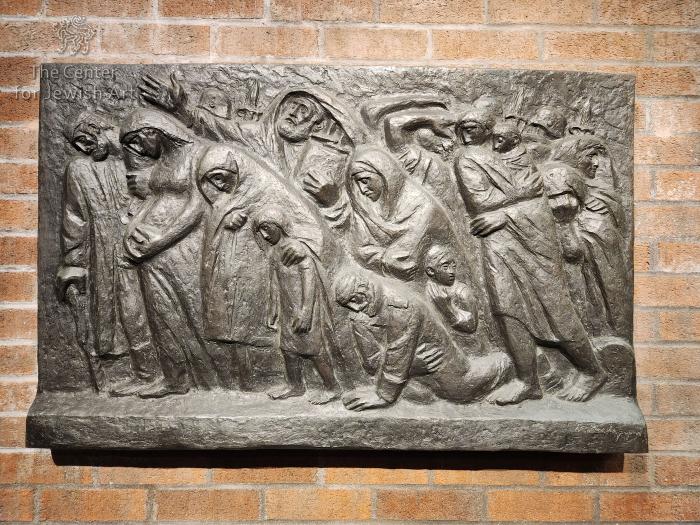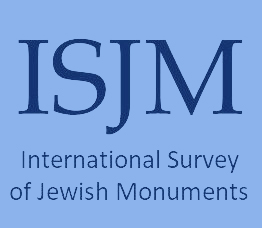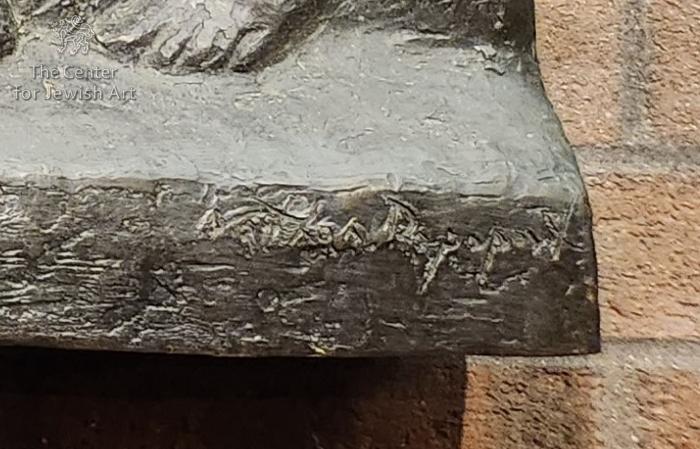Obj. ID: 53377 The Last March Holocaust Memorial in Temple Adath in Syracuse, NY, USA, 1979

Name of Monument
The Last March
Who/What is Commemorated?
Jewish victims of the Warsaw Ghetto (by extension all victims of the Holocaust)
Description
The rectangular bronze relief is installed on the left wall of the entrance passage to the main sanctuary of Temple Adath Yeshuran. The scene shows a cross section of the Jewish population of the Warsaw Ghetto from infants to old people, as they are led to their deaths. Nazi soldiers are nly intimated by their helmets and rifles seen in low relief behind the figures of Jewish martyrs. A figure of a bearded man carrying a Torah scroll is at the center top of the relief, and his outstretch arm animates the scene. For the most part the other figures are bent over and turn in among themselves as the trudge forward. This relief – unlike the original in Warsaw on which it is based – adds a figure of a man fallen to his knees in the front center.
Inscriptions
The Last March
by Nathan Rapoport
donated by
Dr. Henry and Erna Rubinstein
Survivors of the Shoah,
their family and friends
Commissioned by
Henry S. Rubinstein and Erna F. Rubinstein
| Temple Adath Yeshuran 450 Kimber Rd, Syracuse, NY 13224 USA
Lower right corner of relief
Dr. Henry S. Rubinstein and Erna F. Rubinstein, both Holocaust survivors, donated the sculpture to the synagogue in March 1971 in honor of their 25th anniversary. The dedication took place on April 15, 1977, in commemoration of Yom HaShoah, a day of remembrance for the victims of the Holocaust. Subsequently, in 2014, the relief was cleaned and reinstalled at the entrance of the main sanctuary of the synagogue.
This bronze relief is a once of several versions of The Last March, sculpted by Polish-Jewish artist Nathan Rapoport. The scene is non-specific, but as originally conceived and placed on the Warsaw Uprising Monument in Warsaw, it was understood that this relief represented Victims’ march to the Umschlagplatz, from where they were transported by train to their deaths, mostly at Treblinka. The first version is carved in stone as part of the Warsaw Ghetto Uprising Monument, was dedicated in Warsaw in 1948. A plaster cast, said to be made in Paris in 1947, is in the collection of the Jewish Historical Institute in Warsaw. A subsequent bronze version was installed at Yad Vashem in Jerusalem in 1977.
The bronze relief in Syracuse is related to these but is a later reworking of the subject. Stylistically, it is more expressive, with less attention to fine detail of figures and faces. It has different dimensions (smaller) and several of the figures, including the central one of the “rabbi” with Torah Scroll have been changed. The Syracuse relief also introduce an additional figure of a man falling to his knees in the center front of the relief. At least two other reliefs like that in Syracuse are in American synagogues – one in New York City and one in Dallas, Texas.
Young, James. The Texture of Memory: Holocaust Memorials and Meaning. (New Haven & London: Yale University Press, 1993).
“Temple Adath Yeshuran,” Jewish Observer (Syracuse, NY), May 1, 2014, https://issuu.com/jfcny/docs/syr0429_2086cc7250c730 (accessed March 13, 2024)







